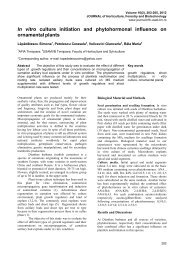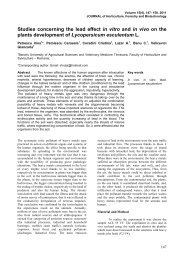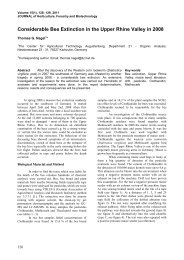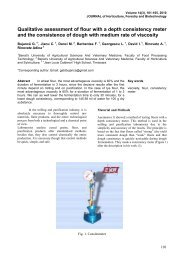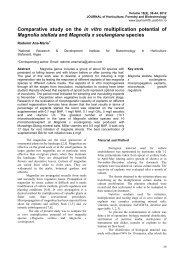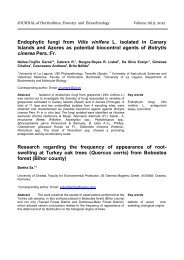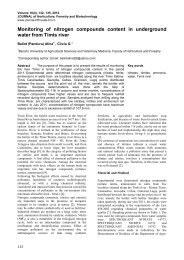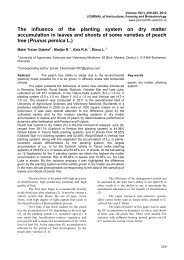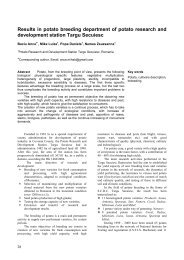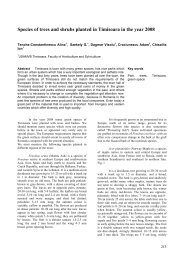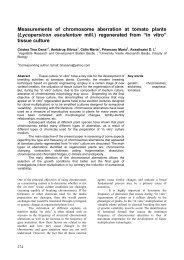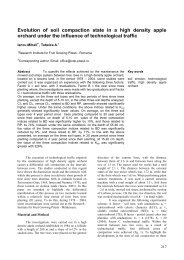Parasitoids of Ips typographus (Coleoptera: Scolytidae) - Journal of ...
Parasitoids of Ips typographus (Coleoptera: Scolytidae) - Journal of ...
Parasitoids of Ips typographus (Coleoptera: Scolytidae) - Journal of ...
Create successful ePaper yourself
Turn your PDF publications into a flip-book with our unique Google optimized e-Paper software.
Volume 16(1), 171-173, 2012<br />
JOURNAL <strong>of</strong> Horticulture, Forestry and Biotechnology<br />
www.journal-hfb.usab-tm.ro<br />
Predators <strong>of</strong> Pityogenes chalcographus (<strong>Coleoptera</strong>:<br />
<strong>Scolytidae</strong>) in Natural Park Apuseni<br />
Fora, C.G. 1* , Lauer, K.F. 2 , Berar, C. 1 , Ştefan, C. 1 , Silivăşan, M. 1 , Lalescu, D. 1<br />
1 Banat University <strong>of</strong> Agricultural Sciences and Veterinary Medicine from Timisoara; 2 University <strong>of</strong> Applied<br />
Sciences Weihenstephan-Triesdorf<br />
* Corresponding author. Email: foraciprian@yahoo.com<br />
Abstract Alongside the European spruce bark beetle, in the Natural Park<br />
Apuseni, the small spruce bark beetle Pityogenes chalcographus encountered<br />
favourable mass reproduction conditions. Thus, massive attacks at the trees’<br />
feet were observed in different arboreta. This phenomenon will largely spread<br />
unless urgent measures for eradicating the pest hole are undertaken. This is<br />
why we have decided to investigate the parasitoid populations for Pityogenes<br />
chalcographus in the protected environment. In 2011 the most numerous<br />
species were: Nemosoma elongatum, Rhizophagus cribratus, Rhizophagus<br />
depressus, Thanasimus formicarius, Quedius plagiatus, Quedius lateralis,<br />
Quedius cruentus, Quedius xanthopus.<br />
The Natural Park Apuseni, 75.784 ha in surface, is<br />
situated in the Bihor Mountains <strong>of</strong> the Western<br />
Romanian Carpathians.<br />
The construction <strong>of</strong> the natural park took place in<br />
2004, in order to protect the karstic values <strong>of</strong> the area,<br />
the tradition and the flora and fauna biodiversity, listed<br />
as V IUCN category - Protected areas. In the protected<br />
area two zones were created. The first one is a<br />
conservation zone, occupying approximately 18% <strong>of</strong><br />
the total park surface, and the second one, a buffer<br />
zone, occupying the rest <strong>of</strong> the surface, approximately<br />
82%.<br />
In the natural park, wood vegetation is dominant<br />
and it covers approximately 75% <strong>of</strong> its total surface.<br />
Wood species are mainly represented by spruce (70%),<br />
beech (27%), fir (2%). Other resinferous species are<br />
represented, like the scots pine and the larch or<br />
deciduous species like the ash, the holm, the sycamore<br />
maple, the birch and the elm, which get mixed up with<br />
the dominant species. The spruce either forms pure<br />
arboreta or it mixes with the ash and the fir forming<br />
valuable arboreta.<br />
Together with <strong>Ips</strong> <strong>typographus</strong>, due to its size and<br />
to the fact that it predominantly attacks the crown <strong>of</strong><br />
the host trees, Pityogenes chalcographus is in its turn<br />
one <strong>of</strong> the most important predators <strong>of</strong> the spruce in<br />
Romania. That is why we have to examine it most<br />
carefully. We are motivated by the fact that, initially,<br />
the Pityogenes chalcographus attacks thin parts <strong>of</strong> the<br />
Key words<br />
Pityogenes chalcographus,<br />
predators, Natural Park<br />
Apuseni<br />
spruce’s crown, contributing thus to their<br />
supplementary destabilization and creating favourable<br />
conditions for the installation <strong>of</strong> the <strong>Ips</strong> <strong>typographus</strong><br />
species, which undertakes the final blow leading to the<br />
desiccation and death <strong>of</strong> the attacked trees. The only<br />
chance <strong>of</strong> stopping the mass reproduction <strong>of</strong> the <strong>Ips</strong><br />
<strong>typographus</strong> species as well as <strong>of</strong> the Pityogenes<br />
chalcographus pest is to transport the infested wood<br />
outside the arboreta (Feicht, 2004). Unless immediate<br />
measures are undertaken in order to stop such attacks,<br />
the effects upon natural or planted forests will be<br />
catastrophic on large surfaces (Niemeyer et al., 1995;<br />
Dengler, 1995; Weslien and Schroeder, 1996). As a<br />
general rule, the predators <strong>of</strong> the studied species are not<br />
taken into account, since it is estimated that they do not<br />
have a major influence on the abundance in number <strong>of</strong><br />
the pest species. The hypothesis that parasitoids have a<br />
decisive influence in the reduction <strong>of</strong> pest populations<br />
is not yet fully verified.<br />
Material and Method<br />
Study area<br />
The sampling areas were set in the special<br />
conservation zone <strong>of</strong> the Natural Park Apuseni, were<br />
wood material infested by the bark beetle was<br />
identified. Thus, three areas were chosen in Poiana<br />
Ponor, Valea Someşului Cald and Cheile Ordâncuşii<br />
(table 1).<br />
171
Table 1<br />
Characteristics <strong>of</strong> the plots in the Natural Park Apuseni<br />
Location<br />
Arboretum<br />
composition<br />
Average<br />
age<br />
Consistency Litter Altitude Array Declivity Tree<br />
no.<br />
Sample<br />
no.<br />
Poiana Ponor 10MO 100 0.7 4 1160 SV 21 2 8<br />
Valea Someşului<br />
Cald<br />
10MO 120 0.7 3 1175 S 20 2 8<br />
Cheile Ordâncuşii 6MO 4FA 70 0.8 3 868 SE 36 2 8<br />
Sampling method<br />
The sampling trees were chosen from those<br />
infested, and the sampling took place in two takes. The<br />
total tree number and the samples taken are presented<br />
in table 1. The first take <strong>of</strong> peaks and branches was<br />
sampled after flight I (10 June) and the second take<br />
after flight II (27 July). From each tree 4 samples were<br />
taken, thin parts <strong>of</strong> the crown (peaks and branches)<br />
infested by bugs. Each sample measured 1m in length<br />
6-12 cm in diameter, since it is a well know fact that<br />
Pityogenes chalcographus predominanatly attacks<br />
bodies less than 15 cm in diameter (Stolina, 1969).<br />
Thus, in take I 12 infested assays were gathered and in<br />
take II other 12 assays. The samples thus constituted<br />
were numbered, introduced in collectors and set in<br />
three locations near the sampling areas (Padiş, Doda<br />
Pilii, Casa de Piatră).<br />
Collectors<br />
The collectors (figura 1) are made from PE type<br />
transparent pipes, with 30 cm in diameter and 1 m in<br />
length, placed vertically. At their inferior end the<br />
collectors have a broad cone which at its base unloads<br />
in an insect collecting recipient.<br />
172<br />
Fig. 1. Collectors for insects (Natural Park<br />
Apuseni/Padiş)<br />
On their superior side, the collectors have a cloth<br />
which allows inside ventilation but does not allow the<br />
insects to exit. Once in 7 days the insects are collected<br />
in plastic recipients, they are numbered and dated. The<br />
last verifications were carried out in 19.09.<br />
Species identification<br />
The samples were analysed in the Forest<br />
Entomology laboratory <strong>of</strong> the Faculty for Horticulture<br />
and Forestry <strong>of</strong> Timişoara, from the point <strong>of</strong> view <strong>of</strong><br />
the species composition as well as from a quantitative<br />
point <strong>of</strong> view.<br />
Results and Discussions<br />
During the 3 months observation period, 8 main<br />
predator species for the Pityogenes chalcographus<br />
beetle could be identified (figura 2), as follows:<br />
Nemosoma elongatum (<strong>Coleoptera</strong>: Trogositidae),<br />
Rhizophagus cribratus (<strong>Coleoptera</strong>: Monotomidae),<br />
Rhizophagus depressus (<strong>Coleoptera</strong>: Monotomidae),<br />
Thanasimus formicarius (<strong>Coleoptera</strong>: Cleridae),<br />
Quedius plagiatus (<strong>Coleoptera</strong>: Staphylinidae),<br />
Quedius lateralis (<strong>Coleoptera</strong>: Staphylinidae), Quedius<br />
cruentus (<strong>Coleoptera</strong>: Staphylinidae), Quedius<br />
xanthopus (<strong>Coleoptera</strong>: Staphylinidae).<br />
The first three species represented 90.74% (figure<br />
2) <strong>of</strong> the total captured predator number: Nemosoma<br />
elongatum, Rhizophagus cribratus şi Rhizophagus<br />
depressus. Less represented were the species<br />
Thanasimus formicarius, Quedius plagiatus, Quedius<br />
lateralis, Quedius cruentus and Quedius xanthopus. On<br />
all three locations Nemosoma elongatum was the<br />
dominant species <strong>of</strong> main importance. Not the same<br />
can be said about the other 7 species which, together,<br />
represented less than 24% <strong>of</strong> the total captures. The<br />
Nemosoma elongatum species was encountered in<br />
every wood sample from the collectors <strong>of</strong> both take I<br />
and II, thus accounting for the greatest frequency. Next<br />
in line was the predator Rhizophagus cribratus which<br />
represented 25% <strong>of</strong> the take I samples and 67% <strong>of</strong> the<br />
take II samples. Rhizophagus depressus was present in<br />
42% <strong>of</strong> the take I samples and in 50% <strong>of</strong> the take II<br />
samples. Thanasimus formicarius came up in 25% <strong>of</strong><br />
the take I samples and in 25% <strong>of</strong> the take II samples.<br />
Quedius plagiatus was present in 20% <strong>of</strong> the take I<br />
samples and in 20% <strong>of</strong> the take II samples. Quedius<br />
cruentus came up in 17% <strong>of</strong> the take I samples and in<br />
20% <strong>of</strong> the take II samples. Quedius lateralis and<br />
Quedius xanthopus were in 8% <strong>of</strong> the take I samples<br />
and in 17% <strong>of</strong> the take II samples.
100%<br />
80%<br />
60%<br />
40%<br />
20%<br />
0%<br />
17.6. 21.6. 28.6. 5.7. 12.7. 19.7. 26.7. 1.8. 8.8. 15.8. 22.8. 29.8. 5.9. 12.9. 19.9. Total<br />
Nemosoma elongatum Rhizophagus cribratus Rhizophagus depressus Quedius plagiatus<br />
Quedius lateralis Quedius cruentus Quedius xanthopus Thanasimus formicarius<br />
Fig. 2. Specific relative abundance <strong>of</strong> predators in Poiana Ponor, Valea Someşului Cald and Cheile Ordâncuşii<br />
Although 8 predator species were identified in the<br />
wood samples in all three locations <strong>of</strong> the natural park,<br />
we can not say whether they largely influenced the<br />
Pityogenes chalcographus populations. Still, their<br />
presence indicates the fact that there is a connection<br />
between the predators and their pray in the studied<br />
perimeter.<br />
Conclusions<br />
The research carried out on the predators <strong>of</strong> the<br />
spruce bark beetle Pityogenes chalcographus, in 2011,<br />
on 3 locations from the Natural Park Apuseni (Poiana<br />
Ponor, Valea Someşului Cald and Cheile Ordâncuşii)<br />
led to the following conclusions:<br />
1. From the 8 main predator species<br />
identified, Nemosoma elongatum,<br />
Rhizophagus cribratus and Rhizophagus<br />
depressus were the best represented.<br />
Thanasimus formicarius, Quedius<br />
plagiatus, Quedius lateralis, Quedius<br />
cruentus and Quedius xanthopus<br />
represented less than 24% <strong>of</strong> the total<br />
captures.<br />
2. The frequency <strong>of</strong> the predators’ appearance<br />
in the 24 studied samples was <strong>of</strong> 100% for<br />
the Nemosoma elongatum species, 46% for<br />
Rhizophagus cribratus and Rhizophagus<br />
depressus, 25% for Thanasimus<br />
formicarius, 20% for Quedius plagiatus,<br />
18.5% for Quedius cruentus and 12.5% for<br />
Quedius lateralis and Quedius xanthopus.<br />
Acknowledgements<br />
This study was financed by the project “Postdoctoral<br />
School in Agriculture and Veterinary Medicine”,<br />
POSDRU/89/1.5/S/6237, co-financed by the European<br />
Social Fund, through the Sectorial Operational<br />
Programme for Human Resources Development 2007-<br />
2013. We would like to thank the administration <strong>of</strong><br />
Natural Park Apuseni for technical support and general<br />
permission. Also, our thanks to Mister Mircu Adrian<br />
from the Institute for Research and Forest Facilities <strong>of</strong><br />
Timişoara, who helped determine the species.<br />
References<br />
1.Dengler, K., 1995: [Is it possible to control bark<br />
beetles?] Forst und Holz. 50, 244-249.<br />
2.Feicht, E., 2004: <strong>Parasitoids</strong> <strong>of</strong> <strong>Ips</strong> <strong>typographus</strong><br />
(Col., <strong>Scolytidae</strong>), their frequency and composition in<br />
uncontrolled and controlled infested spruce forest in<br />
Bavaria. J. Pest Sci. 77, 165-172.<br />
3.Niemeyer, H., Ackermann, J., Watzek, J., 1995: Eine<br />
ungestörte Massenvermehrung des Buchdruckers (<strong>Ips</strong><br />
<strong>typographus</strong>) im Hochhartz. Forst und Holz. 50, 239-<br />
243.<br />
4.Stolina, M., 1969: The influence <strong>of</strong> bark beetles to<br />
development <strong>of</strong> structure <strong>of</strong> natural montainous forests<br />
in Western Carpathians. Lesnícky ćasopis. 15, 1, 45-<br />
63.<br />
5.Waslien, J. & Schroeder, L.M., 1996: Naturliche<br />
Dynamik des Borkenkäferbefalls nach Windwurf.<br />
Allgemeine Forst Zeitschrift für Waldwirtschaft und<br />
Umveltvorsorge. 51(19), 1052-1055.<br />
173



